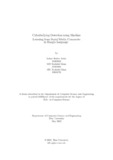| dc.contributor.advisor | Rahman, Mr. Tanvir | |
| dc.contributor.advisor | Bin Ahsraf, Mr.Faisal | |
| dc.contributor.author | Tuhin, Saikat Halder | |
| dc.contributor.author | Islam, MD Touhidul | |
| dc.contributor.author | Islam, MD. Tauhidul | |
| dc.date.accessioned | 2023-01-16T08:31:51Z | |
| dc.date.available | 2023-01-16T08:31:51Z | |
| dc.date.copyright | 2022 | |
| dc.date.issued | 2022-05 | |
| dc.identifier.other | ID: 18301063 | |
| dc.identifier.other | ID: 18301106 | |
| dc.identifier.other | ID: 19101276 | |
| dc.identifier.uri | http://hdl.handle.net/10361/17732 | |
| dc.description | This thesis is submitted in partial fulfillment of the requirements for the degree of Bachelor of Science in Computer Science, 2022. | en_US |
| dc.description | Cataloged from PDF version of thesis. | |
| dc.description | Includes bibliographical references (pages 42-44). | |
| dc.description.abstract | Cyberbullying which is defined as bullying perpetrated through the use of informa tion and communication technology is a serious problem nowadays. As a result of
the invention of social networks friendships through different social media, relation ships, and social communications have all gone to a new level with new definitions.
In fact, people become friends with someone whom he/she cannot even know face to
face. With such a huge amount of users on the internet, cyberbullying has become
a widespread global phenomenon. It not only makes a person mentally low but
also has become one of the most important reasons for committing suicide. Being
the seventh most speaking language in the world and increasing usage of the online
platform, Bangla speaking people badly need an effective cyberbullying detection to
handle this issue. In this thesis paper, we explore the spread of cyberbullying in fluence through the pairwise interactions between users. For cyberbullying through
language, we will collect users’ unique comments from social media and check them
with the help of psychological references. After that, those comments will be cat egorized using Word embedding, an evaluation tool to categorize text, so that the
dataset will be shortened and ready for classification. Lastly, the dataset will be to
a machine learning classifier named Random Forest in detecting the cyberbullying
comments. The performance and accuracy of numerous frequently used machine
learning approaches on Bangla text are investigated in this study. In addition, the
influence of user-specific information, such as location, age, gender, number of likes,
number of comments, and so on, is examined for the identification of Bangla cy berbullying. Random Forest is the top effective algorithm for Bangla cyberbullying
identification when just posts or comments are used to identify, according to exper imental data, with 95.78% accuracy. Therefore, Random Forest is used for applying
the approach on social media since it works better. | en_US |
| dc.description.statementofresponsibility | Saikat Halder Tuhin | |
| dc.description.statementofresponsibility | MD Touhidul Islam | |
| dc.description.statementofresponsibility | MD. Tauhidul Islam | |
| dc.format.extent | 44 Pages | |
| dc.language.iso | en_US | en_US |
| dc.publisher | Brac University | en_US |
| dc.rights | Brac University theses are protected by copyright. They may be viewed from this source for any purpose, but reproduction or distribution in any format is prohibited without written permission. | |
| dc.subject | Cyberbullying | en_US |
| dc.subject | Social Media | en_US |
| dc.subject | Suicide | en_US |
| dc.subject | Bangla Language | en_US |
| dc.subject | Word Embedding | en_US |
| dc.subject | Machine Learning | en_US |
| dc.subject | Random Forest | en_US |
| dc.subject.lcsh | Bullying | |
| dc.subject.lcsh | Cyberbullying. | |
| dc.subject.lcsh | Social media--Moral and ethical aspects. | |
| dc.title | Cyberbullying Detection using Machine Learning from Social Media comments in Bangla Language | en_US |
| dc.type | Thesis | en_US |
| dc.contributor.department | Department of Computer Science and Engineering, Brac University | |
| dc.description.degree | B. Computer Science | |

